What Do I Know of Holy Piano Sheet Music Free
⊱ ──────ஓ๑♡๑ஓ ────── ⊰
When you saw the dog on the cover you thought it was TOTM, but it was me, music theory!
Hello! I'm Nova. I love music a whole lot, so you could imagine how excited I was to hear that an in-game lyre would be added, so you can play tunes of any sorts alongside your friends.
Unfortunately, you may be able to fathom my disappointment when I realized that there were a plethora of limitations. From not being to play sharps and flats- being stuck in c major, to overall questionable design and decisions.
If the terms "sharps" or "flats" or "c major" confuse you, worry not. For this is a beginners guide to not only playing songs on the lyre, but music in general.
If you'd like to request a song for me to play and teach, consider clicking here.
⊱ ──────ஓ๑♡๑ஓ ────── ⊰
Table of contents:
➛ What are the symbols to the left of the notes?
➛ Why are those symbols important?
➛ What is "do, re, mi" etc?
➛ Why is it difficult to play by ear?
➛ Can you use sheet music for the lyre?
➛ How does sheet music transfer to the lyre?
➛ What does the range (C3-B5) mean?
➛ What are sharps and flats?
➛ How can you play sharps and flats on the lyre?
➛ What is a key signature?
➛ How can you tell if a song is in C?
➛ How do you transpose music from another key?
❁ཻུ۪۪♡
Here goes!
*Sol = So, Ti = Si*
What are the symbols to the left of the notes?
These symbols you may see are clefs. Clefs are what determine which notes (or which notes you would call them) are in a certain space. The notes unfortunately are limited to do, re, mi, fa, sol, la, and ti- AKA c, d, e, f, g, a, b.
❁ཻུ۪۪♡
So, why are these clefs important?
These clefs in genshin determine the pitch of the notes. In music terms, essentially genshin allows you to play three different octaves of notes. The highest pitches would be that of treble clef with this symbol- 𝄞. The lowest pitches would be that of bass clef with this symbol- 𝄢. And the middle pitches would be that of c clef- 𝄡. Although "do" would sound exactly the same pitch-wise for all three clefs, the difference between octaves (lowness or highness of the same note) would be drastic from bass clef to treble clef.
❁ཻུ۪۪♡
What is "do, re, mi, fa, sol, la and ti"?
These are notes! The correct term for these kinds of notes are called solfege "soul-fesh", and you most likely encountered them during your elementary years at school. They are pronounces as follows: "dough, ray, me, fah, so(l), lah, tea". Normally "do" would be repeated at the end instead of leaving it at "ti". The reason why is that 1) it sounds a lot more complete, and 2) it ends with the same note, but a higher octave! For example, try playing "do" in bass clef (remember, it looks like this: 𝄢). Then play it in c clef (it looks like this: 𝄡). They both sound the same, right? Just one is significantly higher than the other one.
❁ཻུ۪۪♡
Why is it difficult to play by ear?
Well, there are a plethora of reasons as to why this may be the case. Playing anything, anywhere, by ear is a talent that has to be practiced and honed in on. Anyone can play by ear, but not everyone can do it accurately or efficiently. My recommendation is to find sheet music, which leads me onto my next topic...
❁ཻུ۪۪♡
Can you use sheet music from other instruments for the lyre?
Well short answer is yes. Long answer is be careful.
You can use instruments that are in the key of C. Those are piano (thank god, right? Piano is fairly popular for sheet music), flute, accordion, oboe, violin, etc. I'm not going to go through all of them. Just google "instruments in the key of C". If you're going to use music from, let's say a saxophone piece, you'll have to transpose. Which in short, is hell. Just do yourself a favor and use piano pieces.
IN ADDITION: Kalimba pieces are possibly the EASIEST ways to play music. In fact, you should look for kalimba tabs before searching for piano music. Why? Kalimba is conveniently also in the key of C, and can play the same notes as the lyre. Here is a conversion chart for kalimba tabs:
⊱ ──────ஓ๑♡๑ஓ ────── ⊰
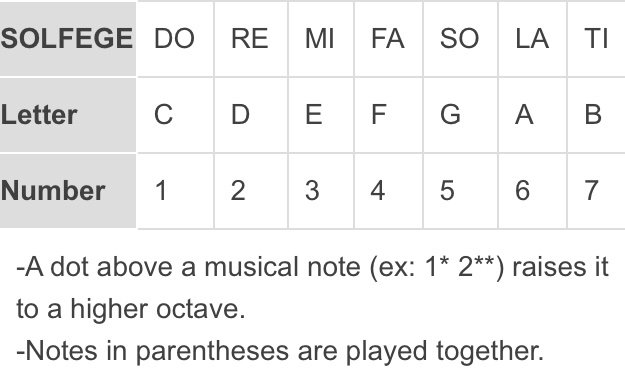
⊱ ──────ஓ๑♡๑ஓ ────── ⊰
All you need to do is transfer the number tabs into solfege, and you're ready to go. But let's take a look at some heavier stuff- real sheet music!
❁ཻུ۪۪♡
How does sheet music translate to the lyre?
Buckle up kids, this one is fun.
The lyre as I mentioned has three clefs. Treble, the "highest"- 𝄞, alto, the second highest- 𝄡, and the "lowest" is bass- 𝄢. The thing is, Genshin is incredibly idiotic and decided to have each clef have a certain range, meaning their notes are very limited. I included an image here to show the ranges for each clef:
⊱ ──────ஓ๑♡๑ஓ ────── ⊰
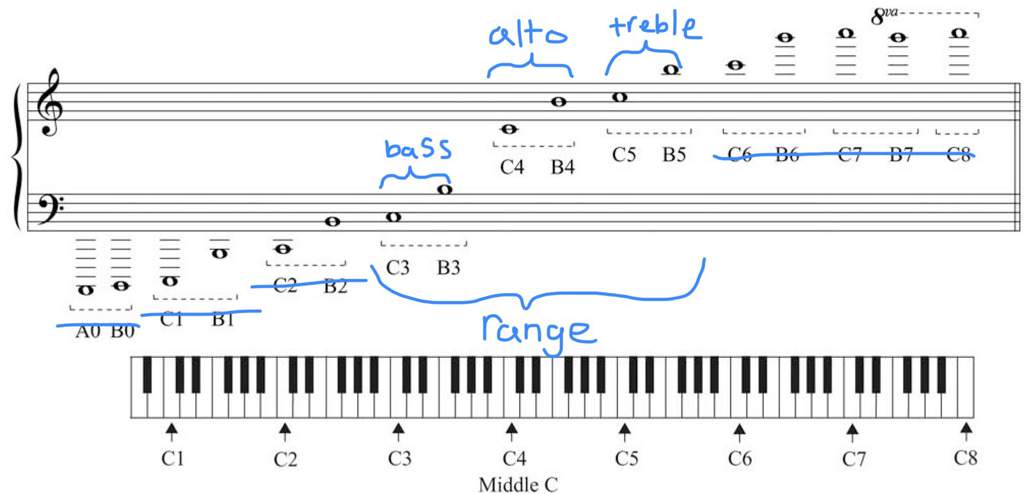
⊱ ──────ஓ๑♡๑ஓ ────── ⊰
This is extremely important to keep in mind. Most instruments DO NOT use the alto clef. When playing music on the lyre from sheet music, you need to be able to note which clef the song is in.
Bass clef's range is from C3-B3. Any notes that are lower in your sheet music are unplayable. I'm terribly sorry. You could go an octave above though, but it'll be higher than ideal.
The alto clef's range is from C4-B4. Although in the image, the notes are on treble clef, they're unplayable on the treble's lyre. You need to play them on alto.
The treble clef's range is from C5-B5. Any notes that are higher are unplayable on the lyre.
❁ཻུ۪۪♡
But Nova, what hecc is C3 or B5? All that's on the lyre is do, re, me, fa, so, and ti!
Great question! Prepare to get a headache.
Genshin, instead of making things easy, decided to use solfege instead of lettered notes. This is very odd in my opinion, considering solfege is mainly used for singing. Basically, solfege represent letters ranging from A-G. So, do is C, re is D, mi is E, fa is F, sol is G, la is A, and ti is B. You need to know this if you're going to be using sheet music to play. Here are the clefs and what solfege are represented:
⊱ ──────ஓ๑♡๑ஓ ────── ⊰
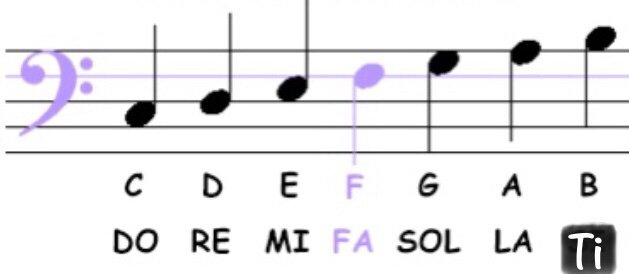
Bass Clef Range with Solfege

Alto clef POSITIONED on treble clef range with solfege

ACTUAL alto clef range with solfege
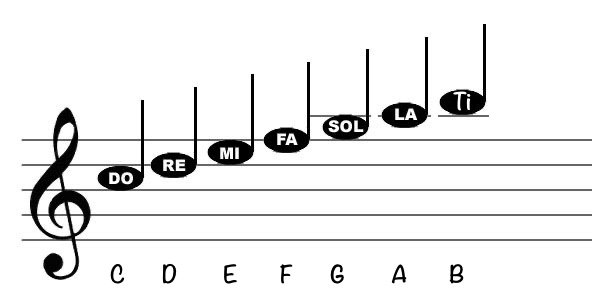
Treble clef range with solfege
⊱ ──────ஓ๑♡๑ஓ ────── ⊰
It's important to keep in mind that any clef can represent any note. Oftentimes, bass clef will have extremely high notes that'll switch to be alto or treble clef. You need to pay attention to the range of these clefs so that you don't make a mistake in your playing the lyre.
Additionally, C clef (alto clef) can be represented with, well, you know, the alto clef.
Here's a great resource for you along with the ranges:
⊱ ──────ஓ๑♡๑ஓ ────── ⊰
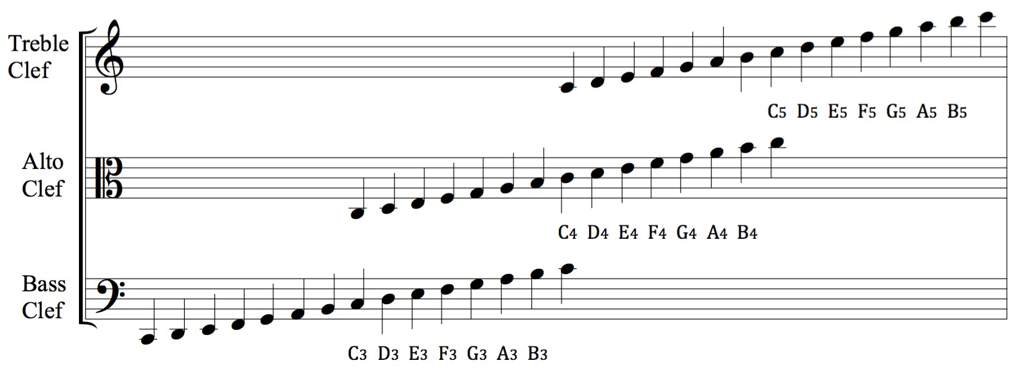
These are the ranges of each clef in genshin impact
⊱ ──────ஓ๑♡๑ஓ ────── ⊰
Notice how these clefs can represent the same note, but generally stick to lower or higher pitches.
So, when you see sheet music such as this:
⊱ ──────ஓ๑♡๑ஓ ────── ⊰
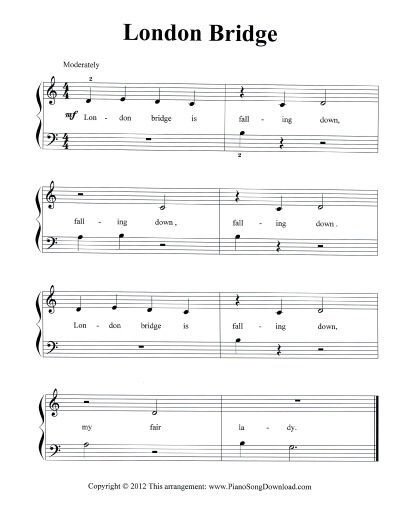
⊱ ──────ஓ๑♡๑ஓ ────── ⊰
We know enough information to turn it into this:
⊱ ──────ஓ๑♡๑ஓ ────── ⊰
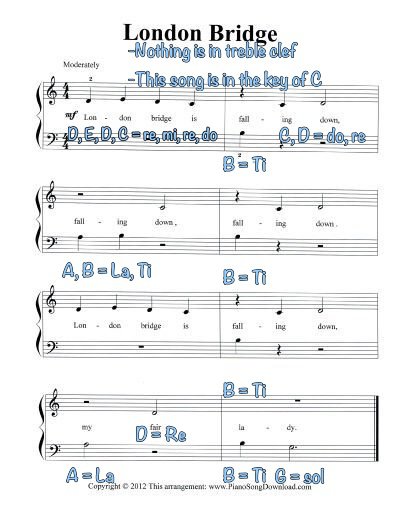
I didn't transpose all of it, but you get the idea.
⊱ ──────ஓ๑♡๑ஓ ────── ⊰
In music, some notes are not always in the key of C. Sometimes they may have these symbols next to them- ♯ and ♭, or the key signature may have those. What do they mean? And how can you play them on the lyre?
Let's tackle these questions bit by bit.
❁ཻུ۪۪♡
What are sharps and flats?
They are notes between notes. Sharps- ♯ represent a pitch that is 1/2 higher, or a half step higher than the note after the sign. So ♯C is a half step (1/2) higher than the original note, C!
Flats on the other hand, do the opposite. Flats- ♭ represent a pitch that is 1/2 lower, or a half step lower than the note after the sign. So ♭B would be 1/2 (a half step) lower than the original note, B!
Because of this, sharps and flats can represent the same note. ♯C can also be represented by ♭D, because one is a half step lower, and the other a half step higher.
This is a very basic description of sharps and flats. I don't need to make this guide longer than it already (sadly) is.
❁ཻུ۪۪♡
How can you play these on the lyre?
Miraculously, genshin impact's wonderful lovely little lyre doesn't have any of these sharps or flats!! Isn't that spectacular? No wonder why half the pieces you play sound so off-
ahem
You can't. Unless if you transpose the music you're using to the key of C (in addition to the instrument being in that key). Even if it is in the key of C and has accidentals (sharps or flats that aren't played throughout the piece, only once or twice), you're practically screwed.
The easiest way to play from sheet music is to 1) find a piano piece (or any other instrument that is in the key of C) and 2) make sure that the piece's key signature is in C as well.
❁ཻུ۪۪♡
But what's a key signature, and how can you tell if the song is in the key of C?
A key signature is represented to the left of your music, typically after the clef. There will be a number of sharps or flats after to the clef. These determine your key signature. If you see ANY flats or sharps, it is NOT in the key of C. For example:
⊱ ──────ஓ๑♡๑ஓ ────── ⊰
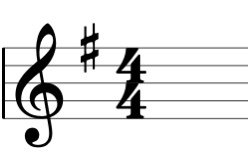
NOT the key of C (this is the key of G)
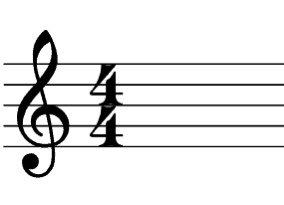
The key of C. Notice how there are no flats or sharps.
⊱ ──────ஓ๑♡๑ஓ ────── ⊰
If you see any sharps or flats in your key signature, you need to transpose the music to the key of C, which is also hell.
❁ཻུ۪۪♡
How do you transpose music from key signature to key signature?
You'll need to substitute the notes for different notes. Here is a chart that will help:
⊱ ──────ஓ๑♡๑ஓ ────── ⊰

Thank you Shii for providing this chart.
⊱ ──────ஓ๑♡๑ஓ ────── ⊰
Let's take G major for example. It contains one sharp. If we move up the boxes, we can find C major.
We can see that G will become C, A to D, F sharp to B, and so on. In your music, you'll have to replace your original notes with these.
So let's say we have a song in G major. It goes as follows: D, D, E, D, G, F sharp. When transposing it to C major, it should go like this: G, G, A, G, C, B. This is now playable on the lyre, and we know how to transpose this with no sharps. This will now be: Sol, Sol, La, Sol, Do, Ti.
This sounds a lot like ninth grade biology, where you'd take the codes of dna and change it to rna, and then code it to amino acids-
⊱ ──────ஓ๑♡๑ஓ ────── ⊰
Alas, I hope you are now able to understand the basics of Genshin's wonderful lyre. This guide is way too long and confusing, but I hope you could learn a bit from it. I plan on going more in depth on how to make and play sheet music for the lyre, so stay tuned.
I'll gladly answer any questions in the comments!
If I made a mistake, please inform me.
⊱ ──────ஓ๑♡๑ஓ ────── ⊰
What Do I Know of Holy Piano Sheet Music Free
Source: https://aminoapps.com/c/genshinimpact/page/blog/how-to-play-your-favorite-songs-on-the-lyre-introduction-to-music/bNrj_W2ksoumPBWXrdYwEvRlP3XeoWZwDaE


0 Response to "What Do I Know of Holy Piano Sheet Music Free"
Post a Comment